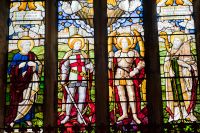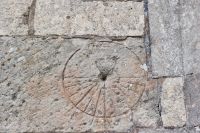
All Saints is built of cobble with some dressed stone and consists of a nave with clerestories, chancel, west tower, aisles, vestry, and south porch.
The first church here was built in 1190, under the patronage of Odo, Count of Albemarle. It was later granted to Aumale Abbey (and later still to Meaux Abbey). This early building was completely rebuilt in the 14th century, and the east window and nave arcades survive from this time. The battlemented clerestories were added in the 15th century.
Carved heads by the east window may represent one of the early Edwards and his queen, perhaps Edward I and Eleanor of Castile?
The oldest interior feature is a medieval incised grave slab tucked into a corner under the tower. This is said to be the lid from the coffin of a medieval priest, and you can clearly make out the outline of two chalices on the worn stone.
Carved into the exterior south wall of the nave are a mass dial and a consecration cross. The mass dial has a set of lines radiating out from the centre, but only covering 180 degrees. one longer arm; this corresponds to 9am, the traditional time of mass. The consecration cross has radiating lines covering a full 360 degrees.
The east window is a lovely 20th-century stained glass creation acting as a war memorial to villagers who died in WWI. The beautifully simple font was given by Archdeacon Long in 1869.






 We've 'tagged' this attraction information to help you find related historic attractions and learn more about major time periods mentioned.
We've 'tagged' this attraction information to help you find related historic attractions and learn more about major time periods mentioned.




